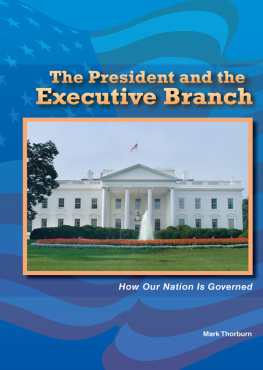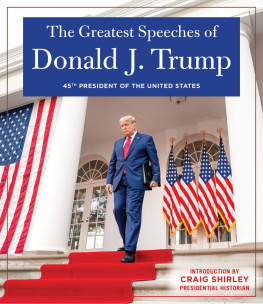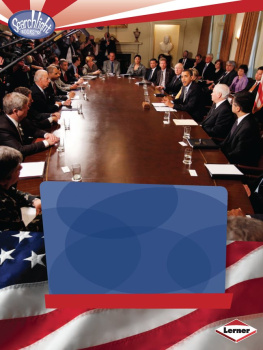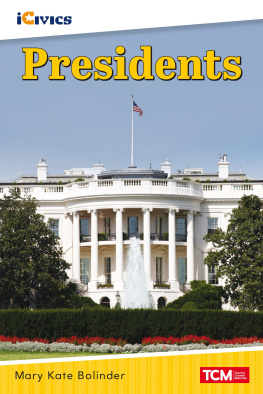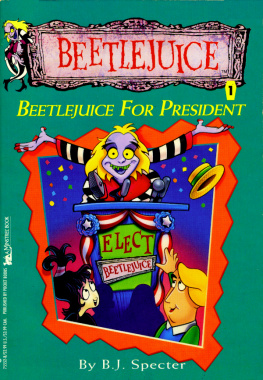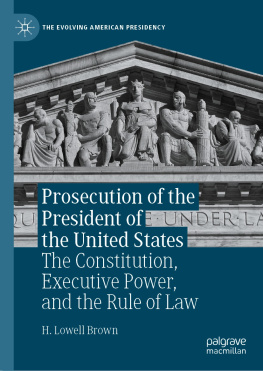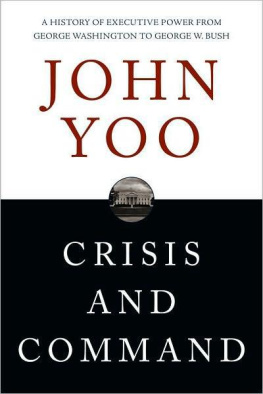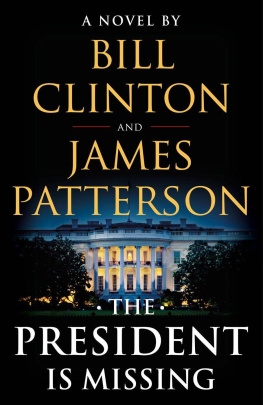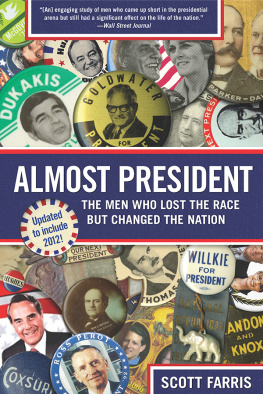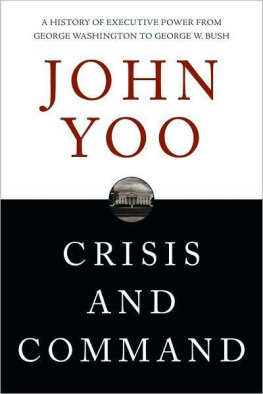Mark Thorburn - The President and the Executive Branch. How Our Nation Is Governed
Here you can read online Mark Thorburn - The President and the Executive Branch. How Our Nation Is Governed full text of the book (entire story) in english for free. Download pdf and epub, get meaning, cover and reviews about this ebook. year: 2013, publisher: Enslow Publishers, genre: Politics. Description of the work, (preface) as well as reviews are available. Best literature library LitArk.com created for fans of good reading and offers a wide selection of genres:
Romance novel
Science fiction
Adventure
Detective
Science
History
Home and family
Prose
Art
Politics
Computer
Non-fiction
Religion
Business
Children
Humor
Choose a favorite category and find really read worthwhile books. Enjoy immersion in the world of imagination, feel the emotions of the characters or learn something new for yourself, make an fascinating discovery.
- Book:The President and the Executive Branch. How Our Nation Is Governed
- Author:
- Publisher:Enslow Publishers
- Genre:
- Year:2013
- Rating:5 / 5
- Favourites:Add to favourites
- Your mark:
- 100
- 1
- 2
- 3
- 4
- 5
The President and the Executive Branch. How Our Nation Is Governed: summary, description and annotation
We offer to read an annotation, description, summary or preface (depends on what the author of the book "The President and the Executive Branch. How Our Nation Is Governed" wrote himself). If you haven't found the necessary information about the book — write in the comments, we will try to find it.
Learn about how the President is elected, what the Presidential duties are, and who runs the nation if the President gets sick.
Mark Thorburn: author's other books
Who wrote The President and the Executive Branch. How Our Nation Is Governed? Find out the surname, the name of the author of the book and a list of all author's works by series.
The President and the Executive Branch. How Our Nation Is Governed — read online for free the complete book (whole text) full work
Below is the text of the book, divided by pages. System saving the place of the last page read, allows you to conveniently read the book "The President and the Executive Branch. How Our Nation Is Governed" online for free, without having to search again every time where you left off. Put a bookmark, and you can go to the page where you finished reading at any time.
Font size:
Interval:
Bookmark:
The Executive Power shall be vested in a President of the United States of America
Within this book you will learn how the president is elected, what the president's duties are, and who runs the country if the president becomes ill or disabled. Also explained are the origins of the presidency, the daily workings and structure of the executive branch, its relationship to the rest of the government, and examples from history that highlight the various roles and powers of the president and Cabinet.
About the Author
Mark Thorburn is a lawyer who previously practiced in Oregon. In addition he served as a part-time pro tem judge and a legislative assistant f or the Oregon Senate's Judiciary Committee. He holds two masters' degrees, one in U.S. history and one in Canadian history.
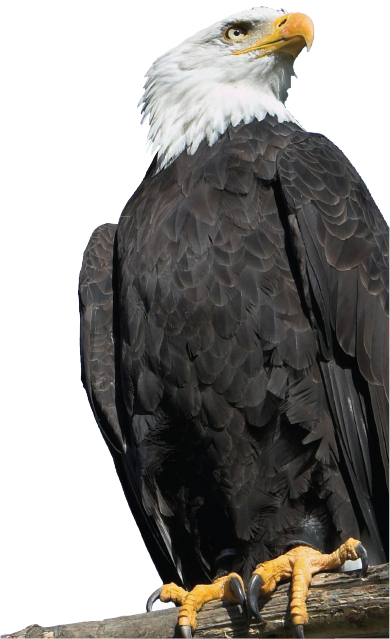
Twice in October 1962, millions of people around the world were glued to their radios and television sets. Americaand the Soviet Union wereon the brink of nuclear war. Peace depended entirely on how Sovietleaders responded to a series of actions, demands, and proposals from President John F. Kennedy of the United States.
The threat began with the discovery of Soviet missiles on the island country of Cuba, just ninety miles off the Florida coast. But the main cause of the Cuban Missile Crisis was the rivalry between the United States and the Soviet Union. After World
War II ended in 1945, the two countries were the only leaders on the globe. They became competitors in a contest to become the leader of the world. This rivalry was known as the Cold War.
One part of this competition was an arms race. The United States and the Soviet Union each tried to build more and more nuclear weapons. The leaders of both countries believed that they needed as many and as powerful weapons as possible in order to deter the other from attacking. The idea was that if both countries could destroy one another, they would never attack each other in the first place.
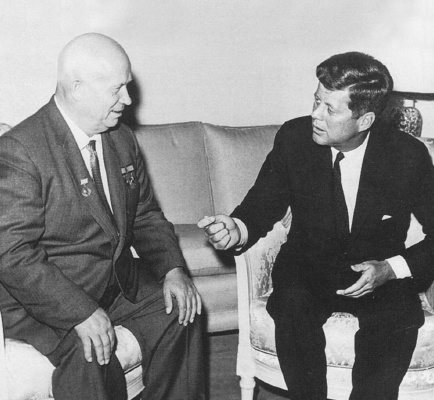
Soviet leader Nikita Khrushchev (left) and U.S. President John F. Kennedy met in Vienna, Austria, in an effort to ease the tensions between the two countries.
Another thing that led to the Cuban Missile Crisis was the bad relationship between the United States and Cuba. In 1959, Fidel Castro took over Cuba. Ties between the two countries quickly turned sour. As this happened, Cuba established friendly relations with the Soviet Union.
In early 1961, the U.S. government attempted to overthrow Castro and his government by invading Cuba. However, this invasion, known as the Bay of Pigs, was a disaster and a major embarrassment for Kennedy and the American government.
Two months after the Bay of Pigs incident, Kennedy met with Soviet leader Nikita Khrushchev in Vienna, Austria, to discuss several important issues. Very little was accomplished, and Khrushchev left Vienna with the impression that Kennedy was a weak leader. In turn, Kennedy thought Khrushchev was a bully. This, combined with the Bay of Pigs, made Kennedy and other American leaders want to appear tough every time they said or did anything about the Cubans or the Soviets.
On October 14, 1962, the pilot of an American spy plane known as a U-2 took photographs of Soviet missile launching pads in Cuba. Next to the pads were Soviet long-range missiles that could be loaded with nuclear warheads. The pictures were shown to President Kennedy. The president immediately put together a group of special advisers called the Executive Committee of the National Security Council (or EXCOMM for short). For the next two weeks, President Kennedy and the EXCOMM discussed ways to respond to the missile threat. Kennedy and the committee also consulted with the heads of the army, navy, and air force as well as various diplomats and other experts.
At first, Kennedy and the EXCOMM were in favor of bombing Cuba, but there was disagreement as to the extent of the attack. Some wanted to bomb only the missile sites, but others insisted on also bombing Cuban air defenses and any Cuban or Soviet bombers that might be found. This would reduce the risk of American planes being shot down during the attack and prevent a retaliatory strike against the United States. A few even wanted to invade Cuba. Then a member of the EXCOMM commented that sneak attacks by one country upon another were immoral and should not be done. It was also pointed out that, no matter what, it was impossible to destroy all of the Soviet missiles in Cuba. It would take only one of them to be launched at the United States for a nuclear war to start.
At this point, the EXCOMM discussed a new idea. President Kennedy could publicly announce the presence of the missiles in Cuba. He could then order a naval blockade of the island to prevent more Soviet missiles from arriving and demand that the Soviet Union remove the missiles that were already there. The term blockade would not be used because, under international law, a blockade was considered an act of war. Instead, the action would be called a quarantine. To the members of the EXCOMM who still wanted to bomb Cuba, this action would serve as a warning to the Soviets. If Khrushchev did not remove the missiles within a few days, then the United States could still attack the missile sites and possibly invade Cuba. Others felt the demand could buy time to find a way to get the missiles out of Cuba without forcing the Soviets into a position where they might feel compelled to start a war.
On October 19, a vote was taken by the EXCOMM. By 12 to 5, it was recommended that President Kennedy blockade Cuba. Some, however, still wanted the president to order an immediate air strike. The EXCOMM then divided into two groups and, on October 20, each presented their arguments to the president. Kennedy decided to go along with the blockade.
On October 22, President Kennedy shocked the world. In a televised seventeen-minute speech, he broke the news that Soviet missile sites had been discovered in Cuba. He tried to reassure the public that no nuclear warheads had been found on the island. Kennedy also announced plans to block all offensive military weapons that were headed to Cuba. Finally, the president made it clear that if the quarantine did not work, then further action (without saying what that action was) would be justified.
The blockade was scheduled to begin on October 24. American warships surrounded Cuba to prevent any ship that contained missile equipment from reaching the island. In case the quarantine did not work or the Soviets decided to go to war, secret orders were issued for an invasion of Cuba. Troops were mobilized and nuclear missiles were readied to fire at the Soviet Union. Twelve submarines, each containing a dozen nuclear missiles, sped toward the Soviet coastline. Long-range bombers with a total of almost two hundred nuclear bombs were also put to flight. Other bombers with more than two thousand nuclear weapons were sent to military and civilian airports around the world. From these locations the bombers could attack the Soviet Union.
Twenty-seven Soviet cargo ships were in the Atlantic Ocean headed to Cuba on October 23. Nineteen of them were believed to carry military equipment, but no one knew what the vessels would do when they reached the quarantine zone the next day. To complicate matters, Soviet leader Khrushchev sent two contradictory messages. In one, he indicated that the Soviets would defy the blockade and continue sailing their ships to Cuba. But in the other, Khrushchev indicated that he was willing to negotiate in order to avoid a war. Furthermore, the Central Intelligence Agency (CIA) reported on October 23 that most of the missile launchpads in Cuba were complete and that the construction of the rest was speeding up. Also on October 23, an American U-2 spy plane was shot down and its pilot was killed while flying over Cuba, and another flying over the Soviet Union was almost intercepted by Soviet fighter planes.
Font size:
Interval:
Bookmark:
Similar books «The President and the Executive Branch. How Our Nation Is Governed»
Look at similar books to The President and the Executive Branch. How Our Nation Is Governed. We have selected literature similar in name and meaning in the hope of providing readers with more options to find new, interesting, not yet read works.
Discussion, reviews of the book The President and the Executive Branch. How Our Nation Is Governed and just readers' own opinions. Leave your comments, write what you think about the work, its meaning or the main characters. Specify what exactly you liked and what you didn't like, and why you think so.

